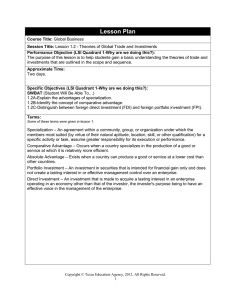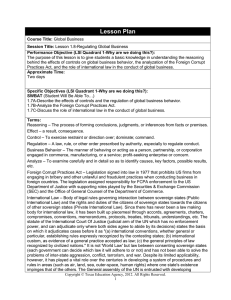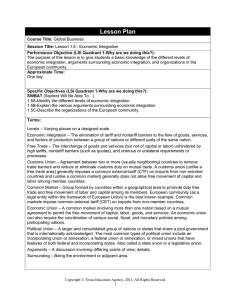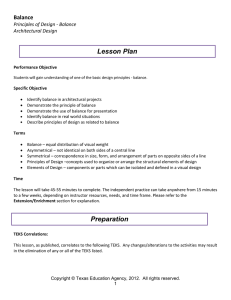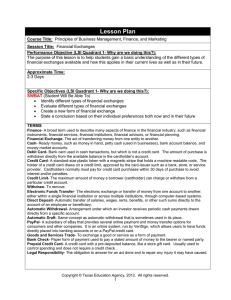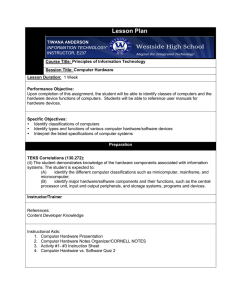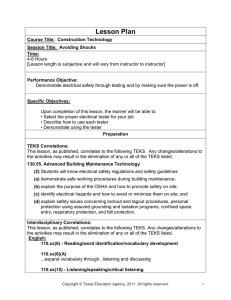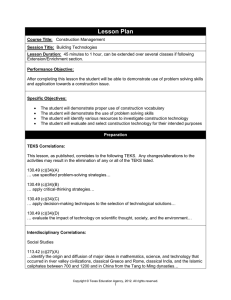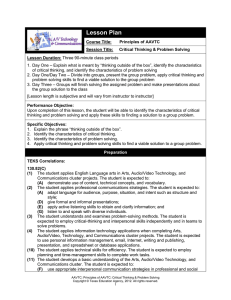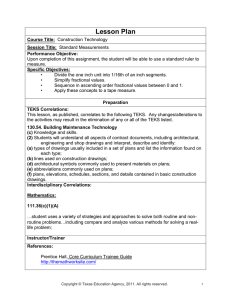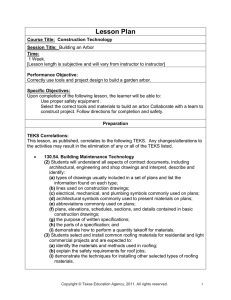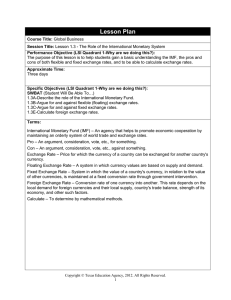Lesson Plan
advertisement
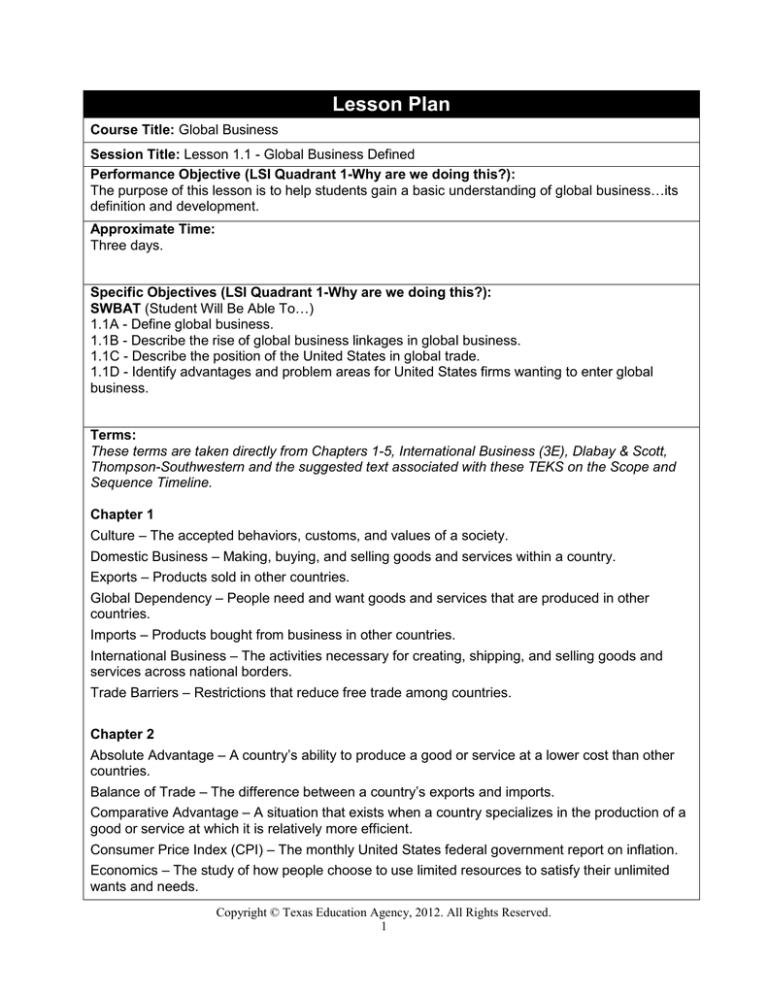
Lesson Plan Course Title: Global Business Session Title: Lesson 1.1 - Global Business Defined Performance Objective (LSI Quadrant 1-Why are we doing this?): The purpose of this lesson is to help students gain a basic understanding of global business…its definition and development. Approximate Time: Three days. Specific Objectives (LSI Quadrant 1-Why are we doing this?): SWBAT (Student Will Be Able To…) 1.1A - Define global business. 1.1B - Describe the rise of global business linkages in global business. 1.1C - Describe the position of the United States in global trade. 1.1D - Identify advantages and problem areas for United States firms wanting to enter global business. Terms: These terms are taken directly from Chapters 1-5, International Business (3E), Dlabay & Scott, Thompson-Southwestern and the suggested text associated with these TEKS on the Scope and Sequence Timeline. Chapter 1 Culture – The accepted behaviors, customs, and values of a society. Domestic Business – Making, buying, and selling goods and services within a country. Exports – Products sold in other countries. Global Dependency – People need and want goods and services that are produced in other countries. Imports – Products bought from business in other countries. International Business – The activities necessary for creating, shipping, and selling goods and services across national borders. Trade Barriers – Restrictions that reduce free trade among countries. Chapter 2 Absolute Advantage – A country’s ability to produce a good or service at a lower cost than other countries. Balance of Trade – The difference between a country’s exports and imports. Comparative Advantage – A situation that exists when a country specializes in the production of a good or service at which it is relatively more efficient. Consumer Price Index (CPI) – The monthly United States federal government report on inflation. Economics – The study of how people choose to use limited resources to satisfy their unlimited wants and needs. Copyright © Texas Education Agency, 2012. All Rights Reserved. 1 Economic System – The method a country uses to answer the basic questions of what to produce, how to produce it, and for whom to produce it. Factors of Production – The three types of resources used to produce goods and services. Foreign Debt – The amount a country owes to other countries. Gross Domestic Product (GDP) – A measure of the productive output of a country within its borders, including items produced with foreign resources. Gross National Product (GNP) – A measure of the total value of all goods and services produced by the resources of a country. Infrastructure – A nation’s transportation, communication, and utility systems. Privatization – The process of changing an industry from public to private ownership. Scarcity – The limited resources available to satisfy the unlimited wants and needs of people. Supply – The amount of a good or service that businesses are willing and able to make available at a certain price. Chapter 3 Body Language – A type of nonverbal communication where facial expressions, upper and lower body movements, and gestures convey what is meant. Class System – A means of dividing the members of a cultural group into various levels. Collectivism – The belief that the group is more important than the individual. Cultural Baggage – The idea that you carry your beliefs, values, and assumptions with you at all times. Culture Shock – A normal reaction to all the differences of another culture. Ethnocentrism – The belief that one’s culture is better than other cultures. Extended Family – A group that consists of parents, children, and other relatives living together. Individualism – The belief in the individual and her or his ability to function relatively independently. Nonverbal Communication – Communication that does not involve the use of words. Nuclear Family – A group that consists of a parent or parents and unmarried children living together. Subculture – A subset or part of a larger culture. Chapter 4 Boycott – Absolute restriction on the import of certain products from certain countries. Common Market – Member countries eliminate trade barriers, encourage investment, and allow workers to move freely across borders. Democracy – A political system in which all people take part in making the rules that govern them. Economic Nationalism – A policy of restricting foreign ownership of local companies and hindering foreign imports. Expropriation – Government takeover of a foreign-owned business. Free Trade Agreement – An arrangement between countries that eliminates duties and trade barriers on products traded among members. Free Trade Zone – Designated area where products can be imported duty-free. Copyright © Texas Education Agency, 2012. All Rights Reserved. 2 Home Country – The country in which a multinational enterprise is headquartered. Host Country – A country in which a multinational enterprise is a guest. MFN Status – Designation given to certain countries that allows their products to be imported into the granting country under the lowest customs duty rates. Political System – Means by which people in a society make the rules by which they live. Protectionism – Government policy used to protect local, or domestic, industries from foreign competition. Quota – A limit on the amount of a product that can be imported from a given country. Social Responsibility – Tax Holiday – Tax incentive used by governments to attract foreign investment where a corporation does not pay income taxes for a time after investing. Trade Embargo – Complete ban on any trade with a particular country. Preparation TEKS Correlations: This lesson, as published, correlates to the following TEKS. Any changes/alterations to the activities may result in the elimination of any or all of the TEKS listed. 1.1 The student identifies steps in implementing the background for starting an international operation. (A) Define global business. (B) Describe the rise of global linkages in global business. (Not represented in this lesson) (C) Describe the position of the United States in global trade. (D) List the advantages and problem areas for United States firms wanting to enter global business. Interdisciplinary Correlations: English-English 1 110.31(b)(1). Reading/Vocabulary Development. Students understand new vocabulary and use it when reading and writing. 110.31(b)(11). Reading/Comprehension of informational text/procedural texts. Students understand how to glean and use information in procedural texts and documents. Copyright © Texas Education Agency, 2012. All Rights Reserved. 3 Occupational Correlation (O*Net – www.onetonline.org/): Job Title: Logistics Managers O*Net Number: 11-3071.03 Reported Job Titles: Logistics Manager, Global Logistics Manager, Integrated Logistics Programs Director Tasks: Direct or coordinate comprehensive logistical or reverse logistical functions for product life cycles including acquisition, distribution, internal allocation, delivery, recycling, reuse, or final disposal of resources…Negotiate with suppliers or customers to improve supply chain efficiency or sustainability…Negotiate transportation rates or services. Soft Skills: Time management, active listening, and communicating effectively in writing. Teacher Preparation: The teacher will review the terms in the outline, presentation slides, and any provided materials to become familiar with the lesson. Teacher should locate and evaluate various resources and websites before the lesson. Teacher will have assignments and website information ready to distribute to students. References: International Business (3E), Dlababy & Scott, Thompson Southwestern Instructional Aids: Products that represent your wants/needs (three of each) Lesson 1.1 Presentation-Global Business Defined Textbook Materials Needed: Lesson 1.1 Presentation-Global Business Defined Lesson 1.1 Formal Assessment Lesson 1.1 Formal Assessment Key Equipment/Software Needed: Projection unit Instructor computer Internet access Electronic system for taking notes Learner Preparation: Discovery Activity slide snapshot copied and pasted below: Copyright © Texas Education Agency, 2012. All Rights Reserved. 4 Introduction Introduction (LSI Quadrant I-Why are we doing this lesson?): ASK: Can you define international business? ASK: Do you personally feel international business is important? ASK: Do you feel the United States thinks international business is important? ASK: Can you currently explain the USA’s position on global international business by identifying ways we encourage and discourage it? ASK: Can you identify the advantages and problem areas for the United States firms wanting to enter global business? ASK: Do you think international business is a good thing for you personally? How about for your family? For your state? Why or why not? SAY: Over the next few days, we’re going to learn what international business is about, try and determine how you feel about it personally and ways our government both encourages and discourages it. Outline Outline (LSI Quadrant II-What are we doing in this lesson?): Instructors can use the presentation program/software, slides, handouts, and notes pages in conjunction with the following outline. MI Outline I. Introduction (Day 1) A. Discovery Activity B. Lesson Objectives C. Need to Know Terms. (See provided presentation for details.) Notes to Instructor For the Discovery Activity, bring in three items that you want/need and do research to find out where those products come from...USA or other country. See presentation for details. Copyright © Texas Education Agency, 2012. All Rights Reserved. 5 II. Guided Instruction (Day 2) A. Notes/Discussion/Lecture Unit 1-The World of International Business 1. C1-We Live in a Global Economy (a) What is international business? (b) Why is international business important? (c) The fundamentals of international trade (d) The international business environment (e) The global business world 2. C2-Our Global Economy (a) The basic economic problem (b) Economic resources satisfy needs 3. C3-Cultural Influences in Global Business (a) Subcultures in society (b) Family relationships (c) Society’s institutions (d) Language differences (e) Learning a second language (f) Direct/indirect/nonverbal communication (g) Values around the world 4. C4-Government and Global Business (a) Political relationships in business (b) Government activities influence business Use the state adopted textbook (International Business (3E), Dlababy & Scott, Thompson Southwestern) to cover key concepts and information in these chapters. This is the resource listed on the Scope and Sequence for these chapters. The time frame allows for only a highlight of these chapters. III. Informal Assessment (Day 1 and/or 2) Check one or all of the following: Need to Know Terms Discovery Activity Notes taken during class lecture/discussion IV. Review (Day 2 and/or 3) Use presentation template to highlight key pieces of information. Copyright © Texas Education Agency, 2012. All Rights Reserved. 6 V. Formal Assessment (Day 3) Verbal Linguistic Logical Mathematical Visual Spatial Musical Rhythmic Bodily Kinesthetic Use provided assessment documents. Intrapersonal Interpersonal Application Discovery-(LSI Quadrant III-How are we going to do this?): Introduction - Slide snapshots copied and pasted below: Guided Instruction (LSI Quadrant III-How are we going to do this?): Notes/Lecture Discussion - Slide snapshots copied and pasted below: Copyright © Texas Education Agency, 2012. All Rights Reserved. 7 Naturalist Existentialist Informal Assessment (LSI Quadrant III-How are we going to do this?): Check one or all of the following: • Need to Know Terms • Discovery Activity • Notes taken during class lecture/discussion Summary Review (LSI Quadrants I-Why are we doing this lesson? and IV-Extending the lesson): Purpose of Assignment-slide snapshot copied and pasted below: Copyright © Texas Education Agency, 2012. All Rights Reserved. 8 Evaluation Informal Assessment (LSI Quadrant III): Check one or all of the following: • Need to Know Terms • Discovery Activity • Notes taken during class lecture/discussion Formal Assessment (LSI Quadrant III, IV): Test - Global Business Defined Extension Extension/Enrichment (LSI Quadrant IV-Extending the lesson): Last slide in presentation. Copyright © Texas Education Agency, 2012. All Rights Reserved. 9 Formal Assessment (LSI Quadrant III-How are we doing this?) Lesson 1.1 Formal Assessment (provided) Grading Rubric-Source: http://www.rcampus.com/rubricshowc.cfm?code=F4A59A&sp=yes& Short Answer Test Assessment Rubric Needs No Answer Improvement 0 pts 4 pts Content 10 pts No Answer Did not answer question. Organization 10 pts (Answers are clearly thought out and articulated.) Writing Conventions 10 pts (Spelling, punctuation, grammar, and complete sentences.) No Answer Did not answer question. No Answer Did not answer question. Needs Improvement Answers are partial or incomplete. Key points are not clear. Question not adequately answered. Needs Improvement Organization and structure detract from the answer. Needs Improvement Displays over five errors in spelling, punctuation, grammar, and sentence structure. Adequate 6 pts Adequate Answers are not comprehensive or completely stated. Key points are addressed, but not well supported. Quality 8 pts Quality Answers are accurate and complete. Key points are stated and supported. Exemplary 10 pts Exemplary Answers are comprehensive, accurate and complete. Key ideas are clearly stated, explained, and well supported. Adequate Quality Exemplary Inadequate organization or development. Structure of the answer is not easy to follow. Organization is mostly clear and easy to follow. Well organized, coherently developed, and easy to follow. Adequate Quality Exemplary Displays three to five errors in spelling, punctuation, grammar, and sentence structure. Displays one to three errors in spelling, punctuation, grammar, and sentence structure. Copyright © Texas Education Agency, 2012. All Rights Reserved. 10 Displays no errors in spelling, punctuation, grammar, and sentence structure. Lesson 1.1 - Global Business Defined Formal Assessment Objective: To determine your level of understanding of how global business is defined, how the USA encourages/discourages it, and the advantages/disadvantages for USA firms wanting to enter global business. Please answer the following questions (be specific and detailed). 1. 2. 3. 4. What is the definition of global business? What is the USA’s position on global business? Identify advantages and problem areas for United States firms wanting to enter global business. What are three terms and their definitions, from each chapter (1-4) that you learned? Each of the first three questions will be worth 30 points and the fourth question will be worth 10 points. Copyright © Texas Education Agency, 2012. All Rights Reserved. 11 Lesson 1.1 - Global Business Defined Formal Assessment Objective: To determine your level of understanding of how global business is defined, how the USA encourages/discourages it, and the advantages/disadvantages for USA firms wanting to enter global business. Please answer the following questions (be specific and detailed). 5. What is the definition of global business? Answers will vary and should include specifics from notes/lecture/discussion. 6. What is the USA’s position on global business? Answers will vary and should include specifics from notes/lecture/discussion. 7. Identify advantages and problem areas for United States firms wanting to enter global business. Answers will vary and should include specifics from notes/lecture/discussion. 8. What are three terms and their definitions, from each chapter (1-4) that you learned? Answers will vary and should be specific. Each of the first three questions will be worth 30 points and the fourth question will be worth 10 points. Copyright © Texas Education Agency, 2012. All Rights Reserved. 12
